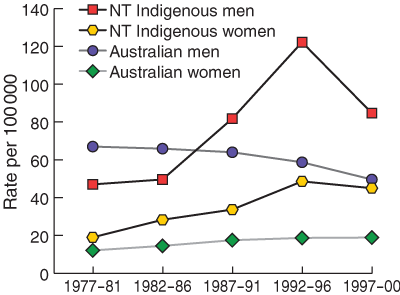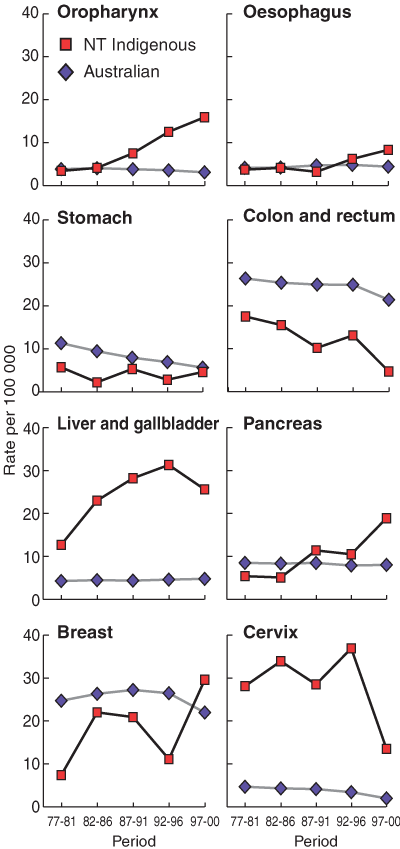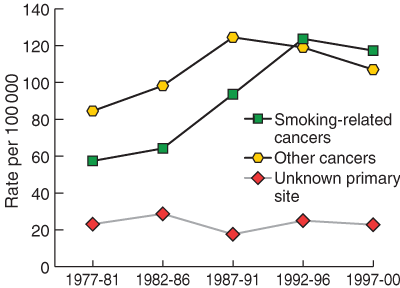Falling mortality rates over recent decades for stomach cancer, lung cancer in men, cervical cancer and, more recently, breast and colorectal cancers are evidence of the effectiveness of cancer prevention and treatment for most Australians.1 To what extent these trends apply to Indigenous Australians is uncertain, because until now studies of Indigenous cancer mortality have been for restricted periods of time, or time trends have not been examined in detail.2,3 This is the first detailed report of long-term trends in Indigenous cancer mortality.
De-identified unit record data were obtained from the Australian Bureau of Statistics (ABS) for all deaths of Northern Territory (NT) residents registered in Australia since 1977. From 1988, Indigenous status was included in NT death notification forms, and identification of Indigenous deaths is estimated by the ABS to be close to complete.4 For deaths before 1988, Indigenous status was inferred from other information in the death register by a previously validated method.5 Data on deaths were analysed by year of death, not year of registration. An internally consistent time-series of Indigenous population estimates for the NT were used to calculate mortality rates.5 Data on deaths for the total Australian population and population estimates were obtained from the Australian Institute of Health and Welfare.6
Cancer deaths in the NT Indigenous population were compared with those in the total Australian population for the period 1991–2000. Cancer deaths were compared for cancers arising at 18 different sites plus those with an unknown primary site. Cancer mortality trends for NT Indigenous people between 1977 and 2000 were examined for 11 cancer sites.
Cancers of the oropharynx (excluding salivary glands), oesophagus, stomach, anus, pancreas, larynx, lung, vulva, penis, bladder, and renal parenchyma and pelvis were grouped as smoking-related cancers. Only a proportion of deaths from each of these specific cancers is caused by smoking,7 but there is insufficient information available for Indigenous Australians to estimate, for each site, the proportion of cancers attributable to smoking over the 24-year period reported here.
Statistical analysis was performed using Stata.8 Analysis of mortality rate ratios (for the NT Indigenous population compared with the total Australian population) was performed using negative binomial regression,8 in preference to Poisson regression, because of overdispersion of death data. Mortality rate ratios were estimated in a model containing age, square of age, sex and indicator variables for the four combinations of population group and age above or below 65 years (ie, total Australian population, 0–64 years; total Australian population, 65 years and over; NT Indigenous population 0–64 years and NT Indigenous population 65 years and over). The term for square of age was included because mortality rates did not increase uniformly with age.
The cancer mortality time trends were analysed using a negative binomial regression model that included terms for age, square of age, sex and year of death. Time trends were reported as the average annual and total percentage increase between 1977 and 2000 for all age-groups combined. The combined male and female age- and sex-standardised mortality rate was used to demonstrate these time trends graphically. The age and sex distribution of the 1991 Australian population was used as the standard population.
There were 484 cancer deaths in NT Indigenous residents in 1991–2000. During this period, cancer mortality rates in the NT Indigenous population were higher for cancers at several sites, and lower for a small number of sites, compared with those for the total Australian population; mortality rate ratios ranged from 9.4 for thyroid cancer to 0.1 for kidney cancer (Box 1). There were no deaths from melanoma in the Indigenous population. For most cancer sites, the mortality rate ratio was higher in younger than older people for most cancers, this difference being statistically significant for six cancers (Box 1).
Between 1977 and 2000, cancer mortality in the NT Indigenous population increased for eight cancer sites and fell for three; the rise was statistically significant for cancers of the oropharynx, lung and pancreas (Boxes 2, 3 and 4). Lung cancer was by far the commonest registered cause of cancer death in NT Indigenous people and mortality from lung cancer doubled between 1977 and 2000. In contrast, lung cancer mortality in all Australians increased by 55% in women and fell by 26% in men over the same period (Box 3).
The breast cancer mortality rate in NT Indigenous people was lower than the total Australian rate, except in 1997–2000, and showed no clear trends (Box 4). In contrast, the NT Indigenous mortality rate for cancer of the cervix was much higher than the total Australian rate, but fell in 1997–2000 to under half the previous rate, although the 95% confidence interval for the annual percentage change was wide (Box 2).
Mortality rates in the NT Indigenous population for all smoking-related cancers more than doubled from 57.4 per 100 000 in 1977–1982 to 117.3 per 100 000 in 1997–2000, showing a greater increase than mortality rates for all non-smoking-related cancers combined (Box 5). Lung cancer, which was the cause of over half of the smoking-related cancer deaths, alone accounted for 21% of all NT Indigenous cancer deaths in 1977–1981, increasing to 26% in 1997–2000, compared with a decrease from 21% to 19% for the total Australian population.
Cancer mortality rates as indicators of Indigenous people’s burden of cancer in the NT present a mixed picture. For several cancers mortality rates are lower than those for the total Australian population, while, for others, particularly smoking-related cancers, the mortality rates are higher, and have increased considerably since 1977. In addition, cancer mortality rates in NT Indigenous people are relatively higher in younger than in older age groups compared with rates for the total Australian population at the same age.
The very high mortality rates for cancer of the cervix are amenable to rapid reduction through preventive Pap test programs, with earlier diagnosis and treatment improving survival. The fall in cervical cancer mortality seen in 1997–2000 may be an early sign of improvement, but longer-term data are required to be certain of any improvement trends.
For cancers with high survival rates in the general Australian population, such as thyroid and breast cancer, Indigenous mortality rates could probably be reduced through earlier diagnosis and improved access to effective treatment. For other cancers with low survival, such as lung, pancreas and liver, longer-term improvements in mortality are possible through preventive strategies, such as smoking reduction and hepatitis B vaccination programs. Ongoing monitoring is important to indicate whether any of these potential gains are being achieved.
Higher cancer mortality rate ratios for younger than older Indigenous people are particularly marked for smoking-related cancers, and probably a consequence of a comparatively recent uptake of smoking by NT Indigenous people,9,10 and the higher levels of tobacco consumption by Indigenous teenagers and young adults in recent decades.11 A “healthy survivor” effect may also play a part if early mortality from other smoking-related diseases lowers the proportion of smokers, particularly heavy smokers, who survive past 65 years of age.
On a more positive note, Indigenous cancer mortality is persistently low for cancers of the colon and rectum, kidney, prostate and melanoma. As Indigenous lifestyles change, mortality from some of these cancers might increase, but this is not yet apparent in the NT.
There are several potential sources of inaccuracy in our findings. Some Indigenous people may be misclassified in death records as non-Indigenous, resulting in incorrectly low Indigenous mortality rates. However, comparison of the cancer mortality rates in the non-Indigenous population of the NT with those in the total Australian population (data not shown) shows that the rates are, if anything, only a little higher than would be expected. Thus, any misclassification of Indigenous status is small and with no apparent time trend. While misclassification of cause of death might also have affected the accuracy of our data,12 it is unlikely that it would account for the large differences between Indigenous and total Australian mortality rates reported here. Indigenous people were included in total Australian mortality rates when these differences were estimated, but they comprise only 2% of the Australian population and their inclusion would have minimal effects on the differences.
The increasing cancer mortality rates, and the more pronounced differences between NT Indigenous and total Australian cancer mortality rates in younger than older adults, demonstrate that cancer is an important and increasing health problem for Indigenous Australians. As cancers affecting Indigenous Australians to a greater extent than other Australians are largely preventable, the major challenges in cancer control lie in prevention — particularly by reducing tobacco consumption, increasing the coverage of Pap smear testing and follow-up treatment, and maintaining high hepatitis B vaccination levels.2 Efforts to prevent these cancers have been increasingly successful over several decades for other Australians. It is high time Indigenous Australians shared in these successes.
1: Cancer mortality rate ratios* (NT Indigenous population compared with the total Australian population), by age group, 1991–2000
Site/type of cancer |
0–64 years |
65 years and over |
All ages† |
Interaction P-value† |
|||||||
Oropharynx |
8.0 (5.5, 11.6) |
2.0 (0.8, 4.8) |
— |
< 0.01 |
|||||||
Oesophagus |
2.9 (1.5, 5.6) |
1.2 (0.5, 2.9) |
1.9 (1.1, 3.2) |
0.11 |
|||||||
Stomach |
1.4 (0.6, 3.0) |
0.2 (0.0, 1.2) |
0.7 (0.3, 1.4) |
0.06 |
|||||||
Colon and rectum |
0.9 (0.5, 1.4) |
0.2 (0.1, 0.6) |
— |
0.01 |
|||||||
Liver and gallbladder |
5.5 (3.6, 8.6) |
5.8 (3.9, 8.6) |
5.7 (4.2, 7.6) |
0.88 |
|||||||
Pancreas |
4.1 (2.7, 6.3) |
1.1 (0.5, 2.2) |
— |
< 0.001 |
|||||||
Lung |
3.6 (2.9, 4.5) |
1.4 (1.0, 1.9) |
— |
< 0.001 |
|||||||
Melanoma |
0.0 |
0.0 |
0.0 |
na |
|||||||
Breast |
0.8 (0.5, 1.3) |
0.9 (0.4, 1.8) |
0.8 (0.6, 1.3) |
0.86 |
|||||||
Uterus‡ |
3.4 (1.1, 10.7) |
2.5 (0.8, 7.6) |
2.9 (1.3, 6.4) |
0.68 |
|||||||
Cervix |
8.0 (5.2, 12.4) |
10.1 (5.4, 19.1) |
8.6 (6.0, 12.3) |
0.56 |
|||||||
Ovary |
1.0 (0.4, 2.6) |
1.3 (0.5, 3.5) |
1.1 (0.6, 2.2) |
0.67 |
|||||||
Prostate |
0.9 (0.2, 3.6) |
0.3 (0.1, 0.8) |
0.4 (0.2, 0.8) |
0.23 |
|||||||
Bladder |
1.5 (0.4, 6.1) |
0.5 (0.1, 1.9) |
0.7 (0.3, 1.9) |
0.24 |
|||||||
Kidney |
0.3 (0.0, 2.2) |
0.0 |
0.1 (0.0, 1.0) |
1.00 |
|||||||
Thyroid |
12.9 (4.8, 34.7) |
6.1 (1.5, 24.7) |
9.4 (4.2, 21.1) |
0.40 |
|||||||
Unknown primary |
3.2 (2.1, 4.7) |
1.7 (1.0, 2.6) |
— |
0.04 |
|||||||
Non-Hodgkin’s lymphoma |
1.1 (0.5, 2.2) |
0.7 (0.2, 1.7) |
0.9 (0.5, 1.6) |
0.40 |
|||||||
Leukaemia |
1.5 (0.9, 2.5) |
0.8 (0.3, 2.0) |
1.2 (0.8, 1.9) |
0.25 |
|||||||
* Mortality rate ratio estimated by negative binomial regression. † Mortality rate ratios are reported separately for age groups 0–64 and 65 years and over; the rate ratio for all ages combined is reported only where the P value of an interaction term testing for difference in mortality rate between younger and older age groups was > 0.05. ‡ Not including cervix. na = not applicable because rate ratio was zero (no NT Indigenous deaths from this cancer in 1991–2000). |
|||||||||||
2: Change in NT Indigenous cancer mortality rates, 1977–2000
Primary site/ type of cancer |
Average annual percentage change (95% CI)* |
Percentage change over 24 years† |
Total cases 1977–2000 |
||||||||
Oropharynx |
9.5 (4.1, 15.1) |
700 |
44 |
||||||||
Oesophagus |
5.6 (− 1.1, 12.7) |
248 |
22 |
||||||||
Stomach |
− 0.8 (−7.4, 6.3) |
− 17 |
18 |
||||||||
Colon and rectum |
− 3.5 (− 7.3, 0.6) |
− 55 |
52 |
||||||||
Liver and gallbladder |
2.1 (−0.9, 5.3) |
62 |
90 |
||||||||
Pancreas |
7.4 (2.3, 12.7) |
415 |
43 |
||||||||
Lung |
3.0 (1.0, 5.0) |
99 |
235 |
||||||||
Breast (female) |
4.4 (−0.5, 9.5) |
168 |
42 |
||||||||
Cervix |
−1.5 (− 5.4, 2.6) |
− 29 |
69 |
||||||||
Non-Hodgkin’s lymphoma |
1.0 (− 5.6, 7.9) |
24 |
20 |
||||||||
Leukaemia |
2.5 (− 2.8, 8.0) |
125 |
31 |
||||||||
All cancers |
|
|
925 |
||||||||
* Average annual percentage change, as estimated by negative binomial regression. † Percentage change over 24 years calculated as annual percentage change raised to the power of 23. |
|||||||||||
3: Lung cancer, 1977–2000

Mortality rate trends for lung cancer for the NT Indigenous population and the total Australian population, by sex, 1977–2000. Mortality rates are age- and sex-standardised to the 1991 Australian population distribution.
- John R Condon
- Joan Cunningham2
- Tony Barnes3
- Bruce K Armstrong4
- 1 Menzies School of Health Research, and Institute of Advanced Studies, Charles Darwin University, Casuarina, NT.
- 2 School of Social and Policy Research, Charles Darwin University, Darwin, NT.
- 3 School of Public Health, University of Sydney, Sydney, NSW.
This work was made possible by the cooperation of the NT Registrar-General and staff of the Registry of Births, Deaths and Marriages, and in particular the Deputy-Registrar, Gail Fleay.
John Condon was supported by postgraduate scholarships from the National Health and Medical Research Council and the Cooperative Research Centre for Aboriginal Health. Bruce Armstrong was supported by a University of Sydney Medical Foundation Program Grant. Joan Cunningham was supported by a National Health and Medical Research Council Career Development Award (No. 283310).
None identified.
- 1. Cancer Epidemiology Centre. Trends in cancer mortality, Australia 1910-1999. Giles G, Thursfield V, editors. Melbourne: Anti-Cancer Council of Victoria, 2001.
- 2. Condon JR, Armstrong BK, Barnes A, Cunningham J. Cancer in Indigenous Australians: a review. Cancer Causes Control 2003; 14: 109-121.
- 3. Dempsey KE, Condon JR. Mortality in the Northern Territory 1979-1997. Darwin: Territory Health Services, 2000.
- 4. Australian Bureau of Statistics. Deaths Australia 2001. Canberra: ABS, 2002. (Catalogue No. 3302.0.)
- 5. Condon JR, Barnes A, Cunningham J, Smith LR. Indigenous mortality and demographic characteristics in the Northern Territory: changes over four decades. Occasional papers. Darwin: Cooperative Research Centre for Aboriginal Health, 2004. In press.
- 6. Population Health Unit. Australian longterm mortality trends workbooks [data file]. Canberra: Australian Institute of Health and Welfare, 2003.
- 7. Australian Institute of Health and Welfare, Australasian Association of Cancer Registries. Cancer in Australia 2000. Canberra: Australian Institute of Health and Welfare, 2003. (Cancer Series No. 23. AIHW Catalogue No. CAN 18.)
- 8. StataCorp. Stata reference manual: release 7.0. College Station Tex: Stata Corporation, 2001.
- 9. Ivers R. Indigenous Australians and tobacco: a literature review. Darwin: Menzies School of Health Research and Cooperative Research Centre for Aboriginal and Tropical Health, 2001.
- 10. Brady M. Historical and cultural roots of tobacco use among Aboriginal and Torres Strait Islander people. Aust N Z J Public Health 2002; 26: 120-124.
- 11. Cunningham J. Cigarette smoking among Indigenous Australians, 1994. Occasional paper. Canberra: Australian Bureau of Statistics, 1997. (Catalogue No. 4701.0.)
- 12. Weeramanthri TS. A medical cause of death validation study of adult Aboriginal deaths in the Northern Territory of Australia in 1992. Public Health 1997; 111: 429-433.







Abstract
Objective: To examine long-term trends in cancer mortality in the Indigenous people of the Northern Territory (NT) of Australia.
Design: Comparison of cancer mortality rates of the NT Indigenous population with those of the total Australian population for 1991–2000, and examination of time trends in cancer mortality rates in the NT Indigenous population, 1977–2000.
Participants: NT Indigenous and total Australian populations, 1977–2000.
Main outcome measures: Cancer mortality rate ratios and percentage change in annual mortality rates.
Results: The NT Indigenous cancer mortality rate was higher than the total Australian rate for cancers of the liver, lungs, uterus, cervix and thyroid, and, in younger people only, for cancers of the oropharynx, oesophagus and pancreas. NT Indigenous mortality rates were lower than the total Australian rates for renal cancers and melanoma and, in older people only, for cancers of the prostate and bowel. Differences between Indigenous and total Australian cancer mortality rates were more pronounced among those aged under 64 years for most cancers. NT Indigenous cancer mortality rates increased over the 24-year period for cancers of the oropharynx, pancreas and lung, all of which are smoking-related cancers.
Conclusions: Cancer is an important and increasing health problem for Indigenous Australians. Cancers that affect Indigenous Australians to a greater extent than other Australians are largely preventable (eg, through smoking cessation, Pap smear programs and hepatitis B vaccination).